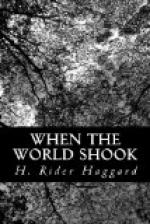Here I may say that its modelling as well as that of the feet and the arm filled Bickley, who, of course, was a highly trained anatomist, with absolute amazement. He said that he would never have thought it possible that such accuracy could have been reached by an artist working in so hard a material.
When the others had arrived we studied this relic as closely as our two candles would allow, and in turn expressed our opinions of its significance. Bastin thought that if those things down there were really the remains of aeroplanes, which he did not believe, the statue had something to do with flying, as was shown by the fact that it had wings on its head and shoulders. Also, he added, after examining the face, the head was uncommonly like that of the idol that he had blown up. It had the same long nose and severe shut mouth. If he was right, this was probably another effigy of Oro which we should do well to destroy at once before the islanders came to worship it.
Bickley ground his teeth as he listened to him.
“Destroy that!” he gasped. “Destroy! Oh! you, you—early Christian.”
Here I may state that Bastin was quite right, as we proved subsequently when we compared the head of the fetish, which, as it will be remembered, he had brought away with him, with that of the statue. Allowing for an enormous debasement of art, they were essentially identical in the facial characteristics. This would suggest the descent of a tradition through countless generations. Or of course it may have been accidental. I am sure I do not know, but I think it possible that for unknown centuries other old statues may have existed in Orofena from which the idol was copied. Or some daring and impious spirit may have found his way to the cave in past ages and fashioned the local god upon this ancient model.
Bickley was struck at once, as I had been, with the resemblance of the figure to that of the Egyptian Osiris. Of course there were differences. For instance, instead of the crook and the scourge, this divinity held a torch. Again, in place of the crown of Egypt it wore a winged head-dress, though it is true this was not very far removed from the winged disc of that country. The wings that sprang from its shoulders, however, suggested Babylonia rather than Egypt, or the Assyrian bulls that are similarly adorned. All of these symbolical ideas might have been taken from that figure. But what was it? What was it?




